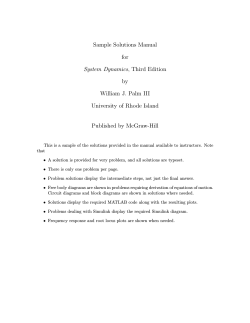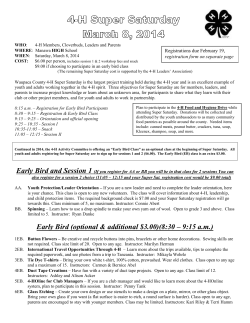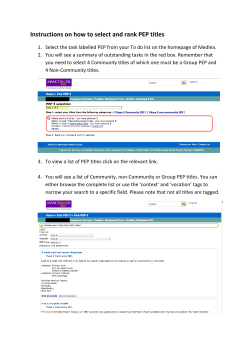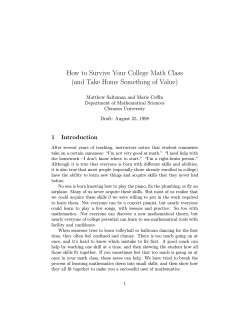
FACULTY’ TECHNOLOGY BARRIERS FACED WITHIN THE FRAMEWORK OF
TOJET: The Turkish Online Journal of Educational Technology – October 2012, volume 11 Issue 4 FACULTY’ TECHNOLOGY BARRIERS FACED WITHIN THE FRAMEWORK OF QUALITY PROCESSES: SAU SAMPLE Prof.Dr. Muzaffer ELMAS Sakarya University EngineeringFaculty, Civil EngineeringDepartment elmas@sakarya.edu.tr ABSTRACT This research was carried out to determine technology barriers faced by the instructors within the framework of quality processes conducted at the University of Sakarya.Therefore, technology barriers encountered in the process of teaching while using web sites developed in order to manage quality operations from a single center were examined within the framework of quality processes. According to the research results, the perceptions of barriers of the instructors did not differ too much according to sex, according to the availability of computer training and according to computer and internet experience. Keywords: Quality management, Technology, barrier, teaching staff INTRODUCTION Total Quality Management at the University of Sakarya started in 2003, and Sakarya University Academic Evaluation and Quality Improvement Committee consisting of the Rector of the university, Deans, college Principals was established in order to organize the quality processes (http://www.saudek. sakarya.edu.tr/index.php?page=gnl&cpage=satoka). Within the framework of quality processes, a quality delegate was assigned for each unit and processes were carried out by these quality delegates on behalf of the units. EFQM model applications began in 2003 started within the context of total quality management practices and as a result of the independent external evaluation in 2006 the university was awarded with the Excellence Award as a public institution for the first time. The mission and vision of the university was determined as the first step of the studies of Quality and principles that university employees must comply with were gradually defined in the light of: quality, education and research, human resources, environment and promotion policies. (http://www.saudek.sakarya.edu.tr/index.php?page= gnl&cpage=mivite) Quality process of Sakarya University has started with Bologna Process. The progress of the so-called Bologna Process, the European-wide project aimed at creating a European Higher Education Area and harmonizing European degree structures, is being followed with concern by the European academic community, from students to administrators (Ahola & Mesikammen, 2003).Twenty nine ministers responsible for higher education signed the Bologna declaration denoting the actual start of the so-called Bologna Process. With this document the ministers agreed on establishing an EHEA by 2010 (Heinze&Knill, 2008).In texts on this issue, there are ideas of comparability,mobility, transparency, flexibility, shared European values and diversity put forward as means of creating a European educational space (Fejes, 2007). The Bologna Declaration laid out policies and joint measures for establishing the EHEA. It included a schedule for achieving the joint objectives thus agreed upon, and a commitment by the Ministers of the countries involved to meet every other year for discussing and assessing progress. The pursuit of the joint policies and measures is commonly referred to as the Bologna process (Neave & Maessen, 2007). Especially Sakarya University in Turkey is one of the leader universities that try to apply Bologna Process decisions. Therefore Sakarya University uses technology in quality process. Three different internet sites were established to carry out total quality studies from a single center and in order to conduct activities online and the board of university, unit directors, lecturers and administrative staff were enabled to display their field related statistical information and academic activities on these sites.The first of these systems is SAUDEK system. Prioritizing the teaching qualifications, departmental, faculty and university qualifications were established through SAUDEK system which stands for Sakarya University Academic Evaluation and Quality Improvement Committee Education Information System (EOBs) is the system through which academicians carry out applications related to their courses and lecture notes. The objective of Education Support System (EODS) is to develop educational activities carried out at the university and to increase the effectiveness of students’ learning processes Within the scope of the quality improvement movement, it was aimed at providing the instructors with the golden opportunity of utilizing the three aforementioned websites to conduct their educational, instructional & academic studies online, to share their lecture notes with their students, to organize their syllabi with the help of the websites, and to maintain an instant contact with students. To that end, some informative meetings were held Copyright © The Turkish Online Journal of Educational Technology 188 TOJET: The Turkish Online Journal of Educational Technology – October 2012, volume 11 Issue 4 for the instructors, and throughout the process, departmental quality delegates did not withhold their assistance from other instructors in the use of the system. The primary objective of the quality improvement process is not only to encourage the instructors to use these websites but also to transform instructional platforms into those in which students maintain an active participation by benefiting from technology. Roblyer & Edwards (2000) mention five motives behind the utilization of technology for educational purposes: • • • • • Increased student motivation Unique instructional capabilities Increased teacher efficiency Enhanced student information age skills Support for constructivist approaches In addition to educational processes, the use of technology accelerates administrative ones too; and renders centralization possible. New technologies are in a race against time has culminated in the evolution of certain issues such as all of the existing learning-instruction theories, instruction methods, environmental design in parallel to the technology (İşman & İşbulan, 2010). Learning technologies offer a wide range of options to enhance the communication and interaction between teachers and students in universities. ICT can be used to realize innovative educational concepts and teaching and learning scenarios (Schneckenberg, 2009). Within the context of the prevailing quality improvement movement at Sakarya University, sights were set on providing students with ease of access to lecture notes, and permitting both instructors and students to have an active role in the administrative process; with this objective in mind, the systems of EOBS, SAUDEK and EODS have been developed. İşman (2011) states that to motivate students in the instruction process, all factors must be determined well. The primary goal of EOBS and EODS are to define the processes well and to maintain students’ active participation in them. Through these two websites, the students are able to be informed from the very the beginning of the semester about the contents of their courses, evaluation policy & grading system, lecture notes, attainments of a course and their relation to the departmental attainments. After a study carried out on a group of executive candidates; İşman, Gündüz and Canan (2008) drew a conclusion that teachers do not have enough time for the integration of technology, and they are devoid of both technological and administrative assistance in that integration process. Furthermore, according to the same research, it’s obvious that technology stands as an important source of anxiety for students. What’s more, the authors specify that the perception of technology as a barrier considerably varies according to gender, the state of owing a computer or not, and of receiving training on computers. İşman and Canan (2008), with their research on teachers and their perception of technology as a barrier, conclude that the financial support for the integration of technology is not sufficient; there are not enough computer labs, the lecturers do not have a good knowledge of technology, and they are not concerned with the integration of it. Moreover, they claim that the teacher candidates’ perception of technology varies according to their gender, the state of having a computer and receiving computer training or not. Pagnucci (1998) in his research identified barriers to technology as follows: lack of technology, fear of technology, cost, lack of software, illiteracy of technology. PURPOSE The purpose of this study is to identify technology barriers faced by the instructors within the framework of the quality implementations.However, after determining the technology barriers faced by the instructors, it was aimed to determine whether the barriers the instructors encountereddifferedaccording to: • • • • • gender, receiving computer training, academic titles, experience of computer use, experience of Internet use DATA COLLECTION TOOL The data collection tools which were used by İşman, Gündüz & Canan (2008) and İşman & Canan (2008) in order to collect the research data, were adapted into quality processes after having obtained permission from the researchers. The data collection tool used in the research consisted of 6 questions defining demographic Copyright © The Turkish Online Journal of Educational Technology 189 TOJET: The Turkish Online Journal of Educational Technology – October 2012, volume 11 Issue 4 characteristics and processes, 28 questions measuring tool identifying barriers faced by instructors within the framework of quality processes. A data collection tool was distributed to the instructors by hand and the ones who were willing to contribute were given 3 days for submission. The 136 questionnaires that were returned from the faculty members at the end of the data collection process were used as the source of the data in research. FINDINGS Table 1. Demographic characteristics of participating teaching staff Gender Computertraining Position Faculty Male Female Yes No Prof.Dr. Assoc.Prof.Dr. Assist.Prof.Dr. Lecturer RA / TA Faculty of Education Faculty of Science Faculty of Fine Arts Faculty of Medicine Law School Faculty of Engineering Faculty of Theology Faculty of Economics and Administrative Sciences Faculty of Technology Faculty of Computer and Information technology Faculty of Business Administration School of Physical Education and Sports Frequency 85 51 83 47 12 15 43 11 55 34 23 7 9 3 18 1 Percent 62.5 37.5 61.0 34.6 8.8 11.0 31.6 8.1 40.4 25.0 16.9 5.1 6.6 2.2 13.2 0.7 11 8.1 3 2.2 5 3.7 17 12.5 3 2.2 Demographic characteristics of instructors participating in the survey are summarized in Table 1. According to the research results of the instructors participating in the survey, 62.5% were male and 37.5%. were female, 61% of the instructors who participated in the research had computer training while 34.6 % did not have computer training.The distribution of titles revealed that, of the instructors participating in the study, 8.8%, were professors, 11% were associate professors, 31.6% were assistant professors, 8.1% were instructors and 40.4% were research assistants.The distribution of the instructors who participated in the research were employed in the faculties as follows. Faculty of education: 25%, faculty of arts and science: 16.9%, faculty of engineering: 13.2%, faculty of economics and administrative sciences: 12.5%. Table 2. Statistical information about the lecturers' experience of using computers and the Internet Experience of Experience of using using computer the internet Mean 15.59 12.41 Median 15.00 12.00 Std. 4.547 3.078 Deviation Minimum 6 5 Maximum 28 20 Copyright © The Turkish Online Journal of Educational Technology 190 TOJET: The Turkish Online Journal of Educational Technology – October 2012, volume 11 Issue 4 According to table 2, faculty members participating in the survey are summarized in descriptive statistics about their experience in using computers and the internet. Table 2 shows that faculty members participating in the survey have an average of 15.59 years of experience of computer use and 12.41 years of experience of internet use. In addition, when looking at the experience of using the computer at extreme values, the least experienced computer user had 6 years of experience while the most experienced one had 28 years of experience and the least experienced internet user had 5 years of experience while the most experienced one had 20 years. Table 3. Responses to the items of the questionnaire according to the t-test results of gender Gender N Mean Quality processes do not have sufficient evidence that the use of technology will improve learning I received support from the other instructors in the use of i internet site competences are uploaded to. Male 83 2.77 Female 49 2.37 Male 83 2.58 Female 50 3.1 I received support from the quality delegates in the use of t internet site competences are uploaded to. Male 83 2.98 Female 50 3.44 t Sig. (2tailed) df 2.458 130 0.015 -2.963 131 0.004 -2.47 131 0.015 The T-test was administered in order to determine whether or not the lecturer responses given to the questionnaire revealed any difference according to gender. According to t -test results, the responses of the instructors differed in only three items according to gender. According to the results, male participants agreed more than female participants with the item stating that there is not enough evidence proving that the use of technology in quality processes will enhance learning (t(130)=2,458,p=0.015). Female participants stated that they received more support from other faculty members than male participants in transferring competences to the internet. (t(131)=-2,963,p=0.004). Similarly, the female participants reported that they received more support from the quality delegates than male participants in uploading competences to the internet (t(131)=2,47,p=0.015). Table 4. Responses to the questionnaire items according to the t-test results of receiving computer training. training N Mean Technology education is inadequate within the framework of quality processes Yes 82 3.5 No 46 3.02 I received support from the faculty management in the use of internet site competences are uploaded to. I received support from the university management in the use of the internet site competences are uploaded to/ Yes No Yes 82 47 82 2.72 2.32 2.77 No 47 2.38 I received support from the quality delegates in the use of the internet site competences are uploaded to. Yes 82 3.29 No 47 2.85 T df Sig. (2tailed) 2.542 126 0.012 2.244 127 0.027 2.151 127 0.033 2.275 127 0.025 The T-test was administered in order to determine whether or not the lecturer responses given to the questionnaire revealed any differences according to whether computer training was received or not. According to t -test results, the responses of the instructors differedin only four items according to whether computer training was received or not. T-test results revealed that participants who received computer training found technology education more inadequatethan participants who did not receive computer training within the framework of quality processes (t(126)=2,542,p=0.012). It was witnessed that participants who received computer training. As for the use of the site competences uploaded to the internet, participants who received computer training received more support from the faculty management(t(127)=2,244,p=0.027), university Copyright © The Turkish Online Journal of Educational Technology 191 TOJET: The Turkish Online Journal of Educational Technology – October 2012, volume 11 Issue 4 management (t(127)=2,151,p=0.033) and quality delegates (t(127)=2,275,p=0.025) than the participants who did not receive computer training Table 5. Responses to the items of the questionnaire according to one –way anova Test results of research participants’ titles Instructors within the framework of quality processes lack technology integration Program standarts are not well defined within the quality framework Technology education is inadequate within the framework of quality processes Instructors do not have enough time for technology integration within the framework of quality Instructors do not have enough time to develop technology assisted activities within the framework of quality Quality framework do not give enough time to integrate technology within the aulity framework I have had a hard time while associating the qualifications of the department with the qualifications of the class, on the web site Between Groups Within Groups Total Between Groups Within Groups Total Between Groups Within Groups Total Between Groups Within Groups Total Between Groups Within Groups Total Between Groups Within Groups Total Between Groups Within Groups Total Sum of Squares 16.860 118.874 135.733 9.170 111.703 120.873 21.504 124.375 145.879 18.846 145.751 164.597 9.449 112.103 df 4 130 134 4 129 133 4 127 131 4 129 133 4 129 121.552 133 8.430 101.813 110.242 9.043 94.205 4 127 131 4 128 103.248 132 Mean Square 4.215 0.914 F Sig. 4.609 0.002 2.292 0.866 2.647 0.036 5.376 0.979 5.489 0.000 4.712 1.130 4.170 0.003 2.362 0.869 2.718 0.033 2.107 0.802 2.629 0.037 2.261 0.736 3.072 0.019 In order to see if the instructors’ responses differed according to their title, one way anova test was administered. According to the Anova Test Results, the responses given by the Instructors differed according to their titles, in 7 items.In the analysis of the responses given to “Instructors do not have enough knowledge on how to integrate with the quality processes” which was done according to the instructors’ titles, there were significant differences (F(4,130)=4,609,p=0,002). In the post-hoc tests administered after one way anova analysis, it was apparent that the research assistantshad less knowledge about how to integrate technology than assistant professors.Another significant difference was observed in the analysis performed according to Instructors’ titles, “The standards for education via technology within the frame of quality was not decided”. (F(4,129)=2,647,p=0,036).Post-hoc tests done after one way anova analysis showed no difference between titles.In the analysis of the responses given to “Technology education within the quality frame, is insufficient” which was done according to the Instructors’ titles, significant differences were found (F(4,127)=5,489,p=0,000). In the post-hoc tests performed after the one way anova analysis, it was found that more instructors working as research assistants see technology education as insufficient, than the instructors working as professors and assistant professors.In the analysis of the responses given to “Instructors do not have enough time for the integration of technology within the frame of quality” which was done according to the instructors’ titles, significant differences were found (F(4,129)=4,170,p=0,003). In the post-hoc tests performed after the one way anova analysis, it was seen that more instructors working as research assistants felt that “instructors do not have as much time for technology integration”than the instructors working as assistant professors.In the analysis of the responses given to “There is not enough financial support to help improve activities supported by technology in the frame of quality” which was done according to the Instructors’ titles, significant differences were found(F(4,129)=2,718,p=0,033). Post-hoc tests done after the one way anova analysis showed no difference between titles.In the analysis of the responses given to “Enough time is not given for integrating technology into educational programmes within the quality framework” which was done according to the Instructors’ titles, significant differences were found(F(4,127)=2,629,p=0,037). Post-hoc tests done after the one way anova analysis showed no difference between titles. In the analysis of the responses given to “I have had a hard time while associating the qualifications of the department with the qualifications of the class, on the web site” which was done according to the Instructors’ titles, significant differences were Copyright © The Turkish Online Journal of Educational Technology 192 TOJET: The Turkish Online Journal of Educational Technology – October 2012, volume 11 Issue 4 found(F(4,128)=3,072,p=0,019).In the post-hoc tests performed after the one way anova analysis, it was apparent that the Instructors working as research assistants were having a harder time with associating themselves with the technology than the Instructors working as assistant professors. Table 6. Responses to the items of the questionnaire according to the t-test results of computer experience Instructors within the framework of quality processes lack of basic information technology Students do not have enough technology in quality processes The internet site competences are uploadedtodoes not work N Mean Inexperienced Experienced Inexperienced Experienced Inexperienced 79 51 79 52 79 3.52 3.12 2.96 2.56 2.73 Experienced 52 2.35 T df Sig. (2tailed) 2.225 128 0.028 2.258 129 0.026 2.478 129 0.015 The T-test was administered in order to determine whether or not the lecturer responses given to the questionnaire revealed any differences according to experience of computer use or not. According to the t -test results, the responses of the instructors differed in only three items according to experience of computer use. The T-test results revealed that participants who lacked experience of computer use, stated that they did not have sufficient knowledge of basic information technology within the framework of quality processes (t(128)=2,225,p=0.028). Besides, participants who lacked experience of computer use stated that students did not have sufficient technology within the framework of quality processes (t(129)=2,258,p=0.026). Inexperienced users complained more than experienced users in that the internet site competences uploaded to did not work (t(129)=2,478,p=0.015). Responses given by instructors to the items of the questionnaire revealed no difference according to the t-test results of computer experience RESULTS According to research results, the majority of the participants were male. Of the participants 61% of instructors had previously received computer training. The instructors’experiences ofusingcomputers and the Internetis analyzedand the instructorsare reported to have been using computers for an average of15:59 years, the internetfor12:41years. As a result of the statistical analysis on the28 item assessment tool, the t-test analysis revealed significant differences according togender in onlythreeitems. Analysis carried out according to receiving computer training or not, showed significant differences in only 4 items. The One Way Anova analysis conducted according to the titles of instructors indicated significant differences in seven items. The analysis carried out according to experience of computers, found significant differences in three items, whereas no significant differences were found in items related to experience of the internet. According to the research results, the instructors’ perceptions of the barriers did not differ widely according to gender, having received computer training or not, computer experience and experiences of the internet. It is suggested that future research topics related to the perceptions of barriers faced by the teaching staff within the framework of quality processes should obtain the views of instructors explained qualitatively and studies should be conducted by selecting a method of qualitative research. REFERENCES Ahola, S. &Mesikammen, J. (2003). Finnish Higher Education Policy and the Ongoing Bologna Process. Higher Education in Europe.28(2), 217-227. Fejes, A. (2008). European Citizens under Construction: The Bologna process analysed from a governmentality perspective.Educational Philosophy and Theory. 40(4). 515-530. Heinze, T &Knill, C. (2008). Analyzing the differential impact of the Bologna Process Theoretical considerations on national conditions for international policy convergence. Higher Education. 56:493510. http://www.saudek.sakarya.edu.tr/index.php?page=gnl&cpage=mivite http://www.saudek.sakarya.edu.tr/index.php?page=gnl&cpage=satoka İşman, A. (2011). Instructional Design In Education: New Model. TOJET: The Turkish Online Journal of Educational Technology – January 2011, volume 10 Issue 1. 136 – 142 İşman, A. & Canan Ö. (2008).Barriers of Adapting Technology by Teacher Candidates.International Educational Technology Conference 2008. Eskisehir. 193 – 198. Copyright © The Turkish Online Journal of Educational Technology 193 TOJET: The Turkish Online Journal of Educational Technology – October 2012, volume 11 Issue 4 İşman, A., Gündüz, H.B. &Canan Ö. (2008).Barriers of Adapting Technology by Education Administrator Candidates.International Educational Technology Conference 2008. Eskisehir. 189 – 192. İşman,A. &İşbulan, O. (2010). Usability Level of Distance Education Website (Sakarya University Sample).TOJET: The Turkish Online Journal of Educational Technology – January 2010, volume 9 Issue 1. 243 – 258. Pagnucci, G.S.(1998). Crossing Borders and Talking Tech: Educational Challenges. Theory Into Practice, Technology and the Culture of Classrooms, 37(1). Ohio. Roblyer, M.D & Edwards, J. (2000). Integrating Educational Technology into Teaching (2nd ed.). Columbus, Ohio: Merrill Neave, G &Maessen, P. (2007) The Bologna, Process: An Intergovernmental Policy Perspective. P. Maassen and J. P. Olsen (eds.), University Dynamics and European Integration, 135–154. Schneckenberg, D. (2009).Understanding the real barriers to technology-enhanced innovation in higher education. Educational Research. 51(4). 411-424. Copyright © The Turkish Online Journal of Educational Technology 194
© Copyright 2025









